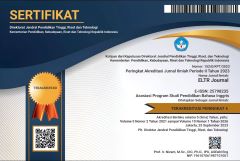STUDENTS’ PERCEPTION OF DIGITAL READING TEXTS: A CASE STUDY AT THE ENGLISH EDUCATION DEPARTMENT OF STKIP PGRI BANGKALAN
Abstrak terlihat: 684 / PDF terunduh: 306DOI:
https://doi.org/10.37147/eltr.v8i2.184Keywords:
digital text, reading, student’s perceptionAbstract
This study investigated what students' perceptions of reading digital texts and students' preferences for digital text reading. Data was gathered through observation, interviews, and documentation to accomplish this purpose. The interview aims to gather qualitative information about the participants' motivation and interests, the effectiveness of reading digital texts, any difficulties they may have had reading them, and whether they preferred reading print or digital texts. Four students enrolled in five semesters of the English Language Education Department at STKIP PGRI Bangkalan during the academic year 2023/2024 participated in this study. The results showed that the participants had a favorable opinion of reading digital materials because digital texts are more engaging and inspiring, and follow the standard reading format. The main obstacle for students in using digital texts is the less text displayed at once due to the limitations of smartphone screens.
Downloads
References
Baba, J., & Affendi, F. R. (2020). Reading habit and students’ attitudes towards reading: A study of students in the faculty of education UiTM puncak alam. Asian Journal of University Education, 16(1), 109–122. https://doi.org/10.24191/ajue.v16i1.8988.
Chakravarthy, C. K. (2020). An exploration of mobile apps to enhance the feasibility of mobile learning in engineering students for effective reading skills. Journal of Xi’an University of Architecture & Technology, XII(IV), 2436–2445. https://doi.org/10.37896/jxat12.04/974.
Furenes, M. I., Kucirkova, N., & Bus, A. G. (2021). A comparison of children’s reading on paper versus screen: A meta-analysis. Review of Educational Research, 91(4), 483-517. https://doi.org/10.3102/0034654321998074.
Grigoryan, A. (2020). Major stages of reading skills development. Armenian Journal of Special Education, 4(2), 42–51. https://doi.org/10.24234/se.2020.1.1.71.
Hennink, M., Hutter, I., & Bailey, A. (2020). Qualitative research methods (2nd ed.). London: SAGE Publications.
Klimova, B., & Zamborova, K. (2020). Use of mobile applications in developing reading comprehension in second language acquisition —A review study. Education Sciences, 10(12), 1–11. https://doi.org/10.3390/educsci10120391.
Koh, H. S., & Herring, S. C. (2016). Historical insights for ebook design. Library Hi Tech, 34(4), 764–786. https://doi.org/10.1108/LHT-06-2016-0075.
Kumbhar, R. (2012). E-books: Review of research and writing during 2010. Electronic Library, 30(6), 777–795. https://doi.org/10.1108/02640471211282109.
Lindawati, N., Jabu, B., & Baa, S. (2022). Students’ perception of the use of WhatsApp in learning EFL during COVID-19 19 at remote area. Journal of Excellence in English Language Education, 1(4), 391–404. https://ojs.unm.ac.id/JoEELE/article/viewFile/37958/17661.
Mambua, Y. (2020). The effectiveness of skimming and scanning techniques in improving student’s reading comprehension of grade eleven students of SMA Negeri 1 Tana Toraja. Journal of Social Science, 1(3), 93–99. https://doi.org/10.46799/jsss.v1i3.38.
Miles, M.B., Huberman, A.M., & Saldana, J. (2014). Qualitative data analysis (3rd ed.). Thousand Oaks, CA: Sage.
Nabilah, A., Azzahra, I. F., Mahdiyyah, N., & Hanifah, R. (2023). An analysis of students’ perception of difficulties speaking English: A case study at 11 th grade students’ of SMAN 7 Kota Serang. JKIP: Jurnal Kajian Ilmu Pendidikan, 4(1), 1–1. https://doi.org/10.55583/jkip.v4i1.694.
Nilamsari, N. (2014). Memahami studi dokumen dalam penelitian kualitatif. Wacana, 8(2), 177–1828.
Novianti, R. (2012). Teknik observasi bagi pendidikan anak usia dini. Jurnal Educhild Pendidikan dan Sosial, 1(1), 22–29. http://dx.doi.org/10.33578/jpsbe.v1i1.1621.
P, D., & K, N.H. (2020). Students’ attitude towards digital reading: A study in universities in Kerala, India. Library Philosophy and Practice, 4387. https://digitalcommons.unl.edu/libphilprac/4387/.
Pardede, P. (2019). Factors attributed to contradictory research findings in print reading vs. digital reading effectiveness: A literature review. Paper presented at Collegiate Forum 2015-2018, Jakarta, Indonesia.
Pardede, P. (2019a). EFL theory and practice: The voice of EED UKI. Paper presented at Collegiate Forum 2015-2018, Jakarta, Indonesia.
Pardede, P. (2019b). Print vs digital reading comprehension in EFL: A literature review. JET (Journal of English Teaching), 5(2), 77-90. https://doi.org/10.33541/jet.v5i2.1062.
Park, H.R., Kim, D., & Vorobel, O. (2020). International students’ reading digital texts on tablets: Experiences and strategies. Journal of Computing in Higher Education, 32, 476–504 (2020). https://doi.org/10.1007/s12528-019-09242-x.
Präkel, D. (2021). The fundamentals of creative photography (1st ed.). London: Routledge. https://doi.org/10.4324/9781003103943.
Pratami, S., Manalullaili, M., & Amrina, R.D. (2024). Reading interest and its relationship to the students’ reading comprehension achievement at English education study program of UIN Raden Fatah Palembang. Literal: English Teaching and Learning Journal, 2(2), 123-136. https://doi.org/10.19109/literal.v2i2.19980.
Pujaastwa, I. B. G. (2016). Teknik wawancara dan observasi untuk pengumpulan bahan informasi (Student paper). Universitas Udayana, Bali.
Purnomo, T., Ismiyati, Y., & Munawwaroh, K. (2021). Students’ perceptions in online learning toward reading comprehension at tenth grade of SMA Negeri 1 Kota Jambi. JELT: Journal of English Language Teaching, 5(2), 130-135. http://dx.doi.org/10.33087/jelt.v5i2.86.
Raskova, L.O., & Asrifan, A. (2019). The use of humor story in improving the students’ reading comprehension. Education, 1(1), 1-16. http://dx.doi.org/10.31219/osf.io/kvsbe.
Santoso, T. N. B., Siswandari, S., & Sawiji, H. (2018). The effectiveness of ebook versus printed books in the rural schools in Indonesia in the modern learning era. International Journal of Educational Research Review, 3(4), 77–84. https://doi.org/10.24331/ijere.453512.
Sun, Y., & Gao, F. (2020). An investigation of the influence of intrinsic motivation on students’ intention to use mobile devices in language learning. Educational Technology Research and Development, 68(3), 1181–1198. https://doi.org/10.1007/s11423-019-09733-9.
Downloads
Published
How to Cite
Issue
Section
License
Copyright (c) 2024 Suhartini Suhartini, Siti Maria Ulfa

This work is licensed under a Creative Commons Attribution-ShareAlike 4.0 International License.













